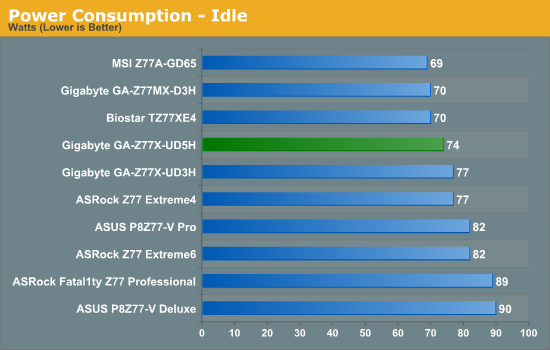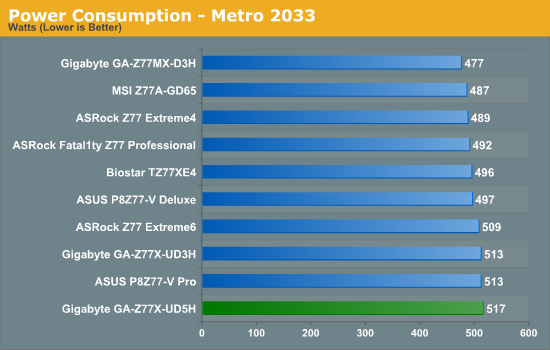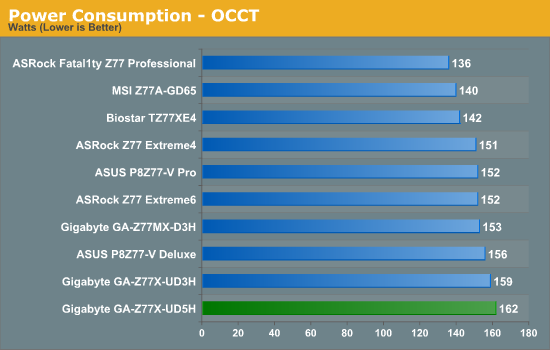Gigabyte GA-Z77X-UD5H Review: Functionality meets Competitive Pricing
by Ian Cutress on July 25, 2012 5:00 AM EST- Posted in
- Motherboards
- Gigabyte
- Z77
Many thanks to...
We must thank the following companies for kindly donating hardware for our test bed:
OCZ for donating the Power Supply and USB testing SSD
Micron for donating our SATA testing SSD
G.Skill for donating our memory kits
ASUS for donating AMD GPUs and some IO Testing kit
ECS for donating NVIDIA GPUs
Test Setup
| Processor |
Intel Core i7-3770K ES 4 Cores, 8 Threads, 3.5 GHz (3.9 GHz Turbo) |
| Motherboards |
ASRock Z77 Extreme4 ASRock Z77 Extreme6 ASRock Fatal1ty Z77 Professional ASUS P8Z77-V Pro ASUS P8Z77-V Deluxe Biostar TZ77XE4 Gigabyte GA-Z77X-UD3H Gigabyte GA-Z77MX-UD3H MSI Z77A-GD65 Gigabyte GA-Z77X-UD5H |
| Cooling | Intel All-in-One Liquid Cooler |
| Power Supply | OCZ 1250W Gold ZX Series |
| Memory |
GSkill RipjawsZ 4x4 GB DDR3-2400 9-11-11 Kit GSkill TridentX 2x4 GB DDR3-2666 11-13-13 Kit |
| Memory Settings | XMP (2400 9-11-11) |
| Video Cards |
ASUS HD7970 3GB ECS GTX 580 1536MB |
| Video Drivers |
Catalyst 12.3 NVIDIA Drivers 296.10 WHQL |
| Hard Drive | Micron RealSSD C300 256GB |
| Optical Drive | LG GH22NS50 |
| Case | Open Test Bed - CoolerMaster Lab V1.0 |
| Operating System | Windows 7 64-bit |
| SATA Testing | Micron RealSSD C300 256GB |
| USB 2/3 Testing | OCZ Vertex 3 240GB with SATA->USB Adaptor |
Power Consumption
Power consumption was tested on the system as a whole with a wall meter connected to the OCZ 1250W power supply, while in a dual 7970 GPU configuration. This power supply is Gold rated, and as I am in the UK on a 230-240 V supply, leads to ~75% efficiency > 50W, and 90%+ efficiency at 250W, which is suitable for both idle and multi-GPU loading. This method of power reading allows us to compare the power management of the UEFI and the board to supply components with power under load, and includes typical PSU losses due to efficiency. These are the real world values that consumers may expect from a typical system (minus the monitor) using this motherboard.



Power consumption for the Z77X-UD5H was low at idle compared to the majority of the motherboards we have tested with, but draws the most power under OCCT and Metro 2033 (though not by much).










70 Comments
View All Comments
jardows2 - Wednesday, July 25, 2012 - link
Can anyone explain the value in multiple Ethernet ports? Outside of being server board, and some specialized workstations, the practicality (and added cost) of multiple Ethernet ports escapes me.IanCutress - Wednesday, July 25, 2012 - link
Connecting to multiple networks, redundancy, teaming for better throughput, connecting via ICS, VM throughput, one specifically for backups, separation of traffic (i.e. you could have a combo web/database server, same network, put all web traffic on one NIC, db traffic on the other, makes it easier to calculate loads for traffic types). If you're streaming from a NAS that supports teaming, then the improved bandwidth can benefit users that stream from that device. Agreed, it is a perhaps a niche scenario, but there are enough users that want it. The Realtek NIC + Audio is a relatively cheap bundle, but some people prefer the Intel NIC. So why not have both, as long as the price for the user is reasonable.Ian
Snotling - Wednesday, July 25, 2012 - link
If your NAS has two ports... you can team up your nick on both ends.If your two NICs have different chip-sets then it may be for compatibility reasons. Some businesses will want to use only the Broadcom or only the Intel or Marvel... etc. Maybe at some point you can save downtime if a driver update causes a problem either by being bugged or missing.
Load balancing, bridging networks, Acting as gateway or firewall... even if you do not actually run a server on the board you may want to do it for test purposes or some weird networking condition. Like having two different VPNs that require you to be on two different subnets.
I admit, most of this is exceptional conditions but the exceptions addup and higher end boards aim to cover the needs of those who may run into those situations or actually need them.
Grok42 - Wednesday, July 25, 2012 - link
I can't figure it out either. I've built boxes with many nics before for routers, gateways and bridges. Almost all the servers I've built have had 4 nics. However, I can't imagine using the two nics on this board for anything. Why would I want to build a NAS box with SLI and overclocking? Why wouldn't I get a much different board and add a good discrete NIC board with multiple ports? At the consumer level I can't imagine doing any of this. My file server only has a single gigabit nic and is WAY faster that I need. I can move GBs of files in just a few seconds between it and my workstations. At work we have 10GB and we team ports to increase even that so I know there are needs for higher speeds, I just can't figure out a reason at the consumer level this board is obviously focused on.Einy0 - Wednesday, July 25, 2012 - link
I own this board, it is amazing thus far. I haven't really had a chance to really push it too hard yet... One of these weekends I will try some overclocking. The 3770K is so fast, I'm still getting used to it. I am really impressed with the Z77's SATA controllers. My Vertex 4 is topping out at about 562MB/s for reads and my 4 disk (500GB WD Blue) RAID5 Array is hitting around 362MB/s for reads. I would love one more USB 2.0 header or a USB 3.0 to 2.0 header adapter. A non Realtek audio codec would be terrific too...vailr - Wednesday, July 25, 2012 - link
There's evidently 2 board versions of the UD5H:The older version has a space in between the 2nd & 3rd DDR3 slots, with blue capacitors.
The newer version has no space in between the 2nd & 3rd DDR3 slots, with purple capacitors.
Question: why doesn't Gigabyte provide drivers for the VIA USB 3.0 ports? There are some VIA USB 3.0 drivers on www.station-drivers.com, but those fail to install on Windows 7 64-bit.
Sabresiberian - Thursday, July 26, 2012 - link
One of Gigabyte's strengths is that they've long had dual Ethernet capability, but -Why only one Intel? Is it really that much more expensive to just put the best in here?
I think your read of Gigabyte has been right on the money Ian, I've long thought the same, and wondered why some media types blew their horn so loudly.
;)
Zak - Saturday, July 28, 2012 - link
I see no point in adding FireWire any more... I'd rather have two eSATA ports or another SPDIF output. Any why having DVI, DP and VGA? Waste of space. I really doubt anyone has a need for all three simultaneously. If someone needs to use VGA they can use DVI or DP adapter.Zak - Saturday, July 28, 2012 - link
Typo: "Overclocking on the UD5H was a mixed back of results"JimDicks - Saturday, July 28, 2012 - link
This GB mainboard comes with a Marvell 9172 6Gbit/s S-ATA controller, almost same as my GB mainboard. When I recently bought a 6Gbit/s SSD and connected it to the 'superb' Marvell, it only reached about 250MB/s instead of the advertised 600MB/s. A whole afternoon searching and reading forums and specifications revealed that most of these 3rd party chips have a higher latency than the Intel/AMD south bridges, and reach much lower data rate than advertised, because they are connected via 1, maximum 2 PCIe 2.0 lanes to the mainboard. That means that a controller with 4 6.0Gbit/s connectors would need 2.4GB/s to transfer, yet it can only theoretically transfer 0.5GB/s (1 lane) or 1.0GB/s (2 PCIe 2.0 lanes) to the mainboard. In fact, the practical PCIe speed is much less.I recommend that Anandtech not only checks USB speeds, but also S-ATA speeds via the 3rd party chips, the southbridge and via external PCIe x8 SAS Raid Controller (ie. LSI MegaRAID SAS 9240 or 9260). The latter could also be used to check the practical PCIe bandwiths.